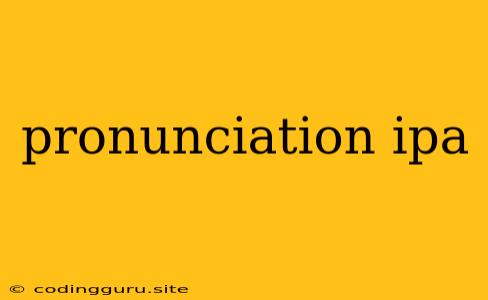Unlocking the Secrets of Speech: Mastering Pronunciation with IPA
Have you ever struggled to pronounce a word correctly, even after reading it several times? Do you find yourself constantly questioning the sounds of different languages? If so, you're not alone. Pronunciation, the art of producing sounds that convey meaning, is a crucial element of language mastery, yet it can often feel like an elusive puzzle.
Fortunately, there's a powerful tool that can help unlock the secrets of speech: the International Phonetic Alphabet (IPA). This system, developed by linguists, provides a unique symbol for every sound in every language. It's like a universal language for pronunciation, offering a clear and consistent way to represent sounds, regardless of the written language.
Why is IPA Important?
Think of it as a road map for spoken language. Just like a map guides you through a city, the IPA helps navigate the complex world of pronunciation. Here's why it's a game-changer:
- Clarity and Consistency: The IPA eliminates the ambiguity often found in traditional alphabets. One letter in one language might have multiple sounds, leading to confusion. The IPA assigns a distinct symbol to each unique sound.
- Global Reach: It's a universal system used by linguists, speech therapists, and language learners worldwide, bridging the gap between different languages and dialects.
- Self-Learning: The IPA empowers you to learn how to pronounce new words on your own. By analyzing the IPA symbols, you can decode the sounds and practice them effectively.
Decoding the IPA: A Quick Guide
The IPA chart is your guide to the world of speech sounds. It features a grid-like arrangement of symbols, categorized by the way the sound is produced (e.g., consonants vs. vowels). Let's break down some key aspects:
- Consonants: These sounds are created by obstructing the flow of air in your mouth, either completely or partially.
- Vowels: These sounds are produced with an open vocal tract, allowing air to flow freely.
- Diacritics: These are small marks added to IPA symbols to indicate specific variations in sound production. For instance, a dot above a symbol might indicate a more aspirated pronunciation.
How to Use the IPA: A Practical Approach
Learning to use the IPA effectively involves a few key steps:
- Familiarize yourself with the chart. Spend time studying the symbols and their corresponding sounds.
- Practice with simple words: Look up words you're unsure about in a dictionary that includes IPA transcriptions.
- Listen to recordings: Find audio recordings of words pronounced by native speakers, paying attention to how the IPA symbols match the sounds you hear.
- Record yourself: Practice speaking the words and listen back to your pronunciation, comparing it to the recordings and the IPA symbols.
Beyond the Basics: IPA for Advanced Learners
The IPA is more than just a tool for beginners. For advanced learners, it can provide:
- A deeper understanding of language variation: You can use the IPA to analyze and compare different accents and dialects, gaining a richer appreciation for the diversity of language.
- Enhanced communication: By mastering the IPA, you can communicate more effectively with language learners and those who speak different dialects.
The Future of Pronunciation: Embracing the IPA
In an increasingly globalized world, effective communication is more vital than ever. The IPA can help us bridge the gaps between languages and dialects, fostering understanding and collaboration. Whether you're a language learner, a teacher, or simply someone curious about the fascinating world of speech, the IPA is a valuable tool for mastering pronunciation and enhancing communication.
Conclusion
The International Phonetic Alphabet is an invaluable resource for anyone seeking to deepen their understanding and mastery of pronunciation. It empowers you to learn, practice, and refine your pronunciation skills, leading to more confident and effective communication across languages and cultures. Embrace the IPA as your guide to unlocking the secrets of speech and discover the joy of speaking with clarity and precision.
